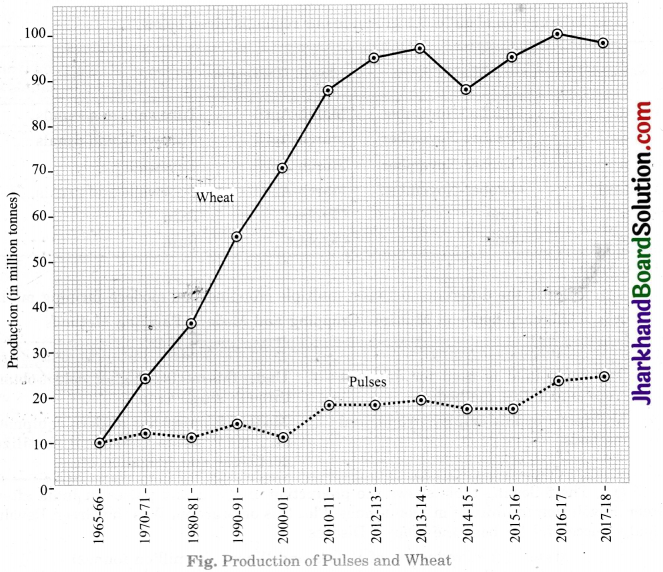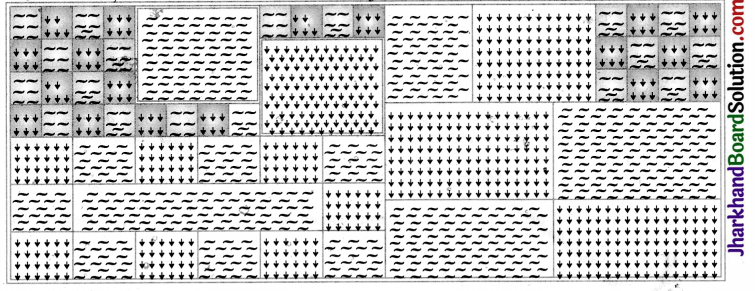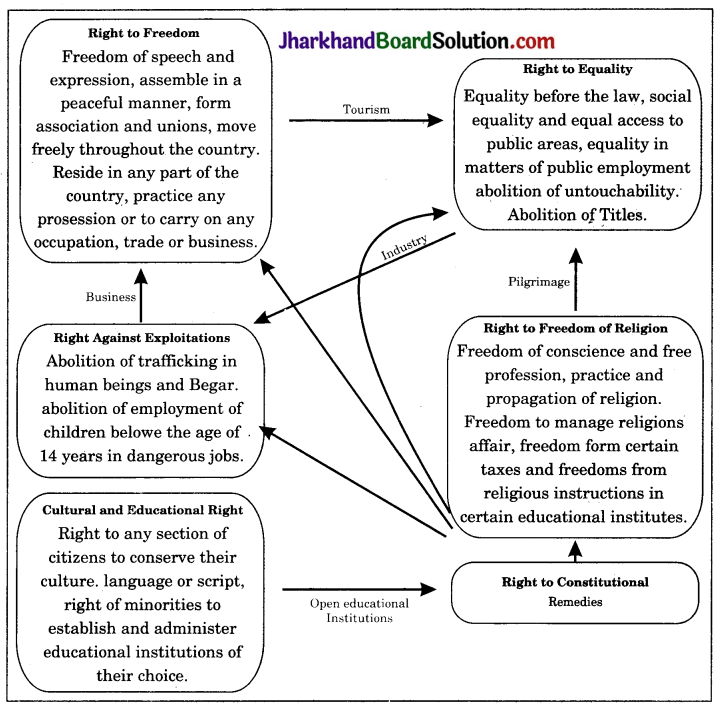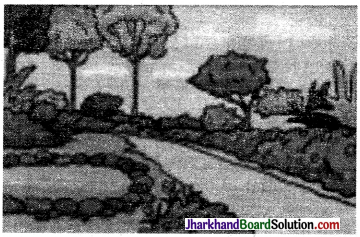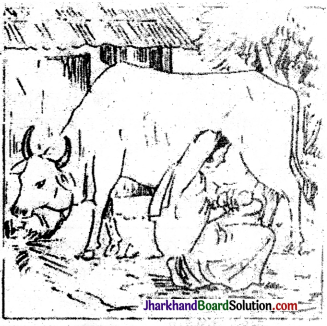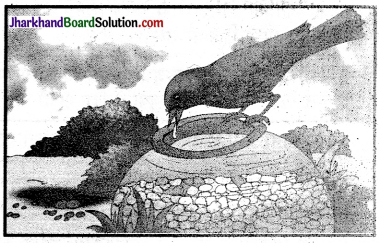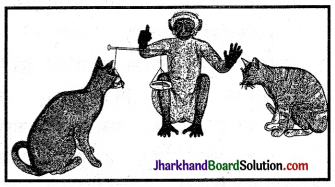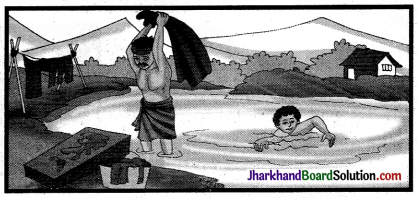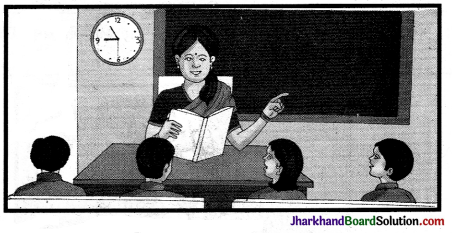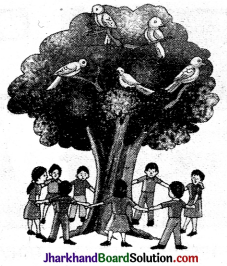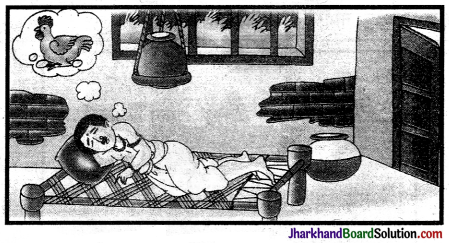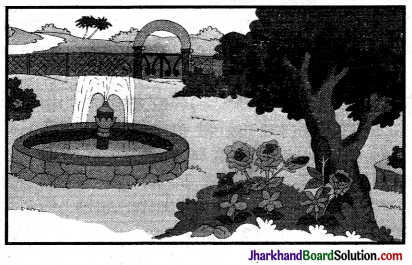Jharkhand Board JAC Class 10 Sanskrit Solutions Shemushi Chapter 6 सुभाषितानि Textbook Exercise Questions and Answers.
JAC Board Class 10th Sanskrit Solutions Shemushi Chapter 6 सुभाषितानि
JAC Class 10th Sanskrit सुभाषितानि Textbook Questions and Answers
प्रश्न 1.
एकपदेन उत्तरं लिखत (एक शब्द में उत्तर लिखो)
(क) मुनष्याणां महान रिपुः कः? (मनुष्यों का महान् शत्रु कौन है?)
(ख) गुणी किं वेत्ति? (गुणी क्या जानता है?)
(ग) केषां सम्पत्तौ च विपत्तौ च एकरूपता? (सम्पत्ति और विपत्ति में समान कौन होते हैं?)
(घ) पशुना अपि कीदृशः ग्रहयते? (पशु द्वारा कैसे ग्रहण किया जाता है?)
(ङ) उदयसमये अस्तसमये च कः रक्तः भवति? (उदय और अस्त के समान कौन लाल रहता है)
उत्तराणि-
(क) आलस्यम् (आलस्य)
(ख) गुणम् (गुण को)
(ग) महताम् (महापुरुषों के)
(घ) उदीरितः (कहा हुआ)
(ङ) सविता (सूर्य)
प्रश्न 2.
अधोलिखितानां प्रश्नानाम् उत्तराणि संस्कृतभाषया लिखत –
(निम्नलिखित प्रश्नों के उत्तर संस्कृत भाषा में लिखिए)
(क) केन समः बन्धुः नास्ति ? (किसके समान भाई नहीं है ?)
उत्तरम् :
उद्यमेन समः बन्धुः नास्ति। (परिश्रम के समान भाई नहीं है।)

(ख) वसन्तस्य गुणं कः जानाति ? (वसन्त के गुण को कौन जानती है ?)
उत्तरम् :
पिको वसन्तस्य गुणं जानाति। (कोयल वसन्त के गुण जानती है।)
(ग) बुद्धयः कीदृश्यः भवन्ति ? (बुद्धियाँ किस प्रकार की होती हैं ?)
उत्तरम् :
परेङ्गितज्ञानफला: हि बुद्धयः। (बुद्धियाँ अर्थात् बुद्धिमान् लोग दूसरे के संकेत से बात को समझने वाले होते हैं।)
(घ) नराणां प्रथमः शत्रुः कः ? (मनुष्यों का पहला शत्रु कौन है ?)
उत्तरम् :
नराणां क्रोधो हि प्रथमः शत्रुः। (मनुष्यों का निश्चित रूप से क्रोध पहला शत्रु है।)।
(ङ) सुधियः सख्यं केन सह भवति ? (बुद्धिमानों की मित्रता किसके साथ होती है ?)
उत्तरम् :
सुधियः सख्यं सुधीभिः सह भवति। (बुद्धिमानों की मित्रता बुद्धिमानों के साथ होती है।)
(च) अस्माभिः कीदृशः वृक्षः सेवितव्यः ? (हमें कैसे वृक्ष का सेवन करना चाहिए?)
उत्तरम् :
अस्माभिः फलच्छाया-समन्वितः महावृक्षः सेवितव्यः। (हमें फल-छाया से युक्त महावृक्ष का सेवन करना
चाहिए।)
प्रश्न 3.
अधोलिखिते अन्वयद्वये रिक्तस्थानपूर्तिं कुरुत (निम्नलिखित दो अन्वयों के रिक्तस्थानों की पूर्ति कीजिए।)
(क) यः ………… उद्दिश्य प्रकुप्यति तस्य ……….. सः ध्रुवं प्रसीदति। यस्य मनः अकारणद्वेषि अस्ति, तं कथं ………… परितोषयिष्यति ?
उत्तरम् :
यः निमित्तम् उद्दिश्य प्रकुप्यति तस्य अपगमे सः ध्रुवं प्रसीदति। यस्य मनः अकारणद्वेषि अस्ति, तं कथं जनः परितोषयिष्यति?

(ख) ……… खलु संसारे ……… निरर्थकं नास्ति। अश्वः चेत् ……… वीरः, खरः ……… (वीरः) (भवति)। उत्तरम-विचित्रे खलु संसारे किञ्चित् निरर्थकम् नास्ति। अश्वः चेत् धावने वीरः, खरः भारस्य वहने (वीरः) (भवति)।
प्रश्न 4.
अधोलिखितानां वाक्यानां कृते समानार्थकान् श्लोकांशान् पाठात् चित्वा लिखत –
(निम्नलिखित वाक्यों के लिए समान अर्थ वाले श्लोकों के अंश पाठ से चुनकर लिखिए)
(क) विद्वान् स एव भवति यः अनुक्तम् अपि तथ्यं जानाति।
(विद्वान वह होता है जो बिना कहे तथ्य को भी जान लेता है।)।
(ख) मनुष्यः समस्वभावै: जनैः सह मित्रतां करोति।
(मनुष्य समान स्वभाव वाले व्यक्तियों के साथ मित्रता करता है।)
(ग) परिश्रमं कुर्वाणः नरः कदापि दुःखं न प्राप्नोति।
(परिश्रम करता हुआ मनुष्य कभी दुःख नहीं पाता है।)
(घ) महान्तः जनाः सर्वदैव समप्रकृतयः भवन्ति।
(महान् पुरुष सदा ही समान स्वभाव के होते हैं।)
उत्तरम् :
(क) अनुक्तमप्यूहति पण्डितोजनः।
(ख) समान-शील-व्यसनेषु सख्यम्।
(ग) नास्त्युद्यमसमो बन्धुः कृत्वा यं नावसीदति।
(घ) सम्पत्तौ च विपत्तौ च महतामेकरूपता।
प्रश्न 5.
यथानिर्देशं परिवर्तनं विधाय वाक्यानि रचयत –
(निर्देशानुसार परिवर्तन करके वाक्य-रचना कीजिए)
(क) गुणी गुणं जानाति। (बहुवचने)
(ख) पशुः उदीरितम् अर्थं गृह्णाति। (कर्मवाच्ये)
(ग) मृगाः मृगैः सह अनुव्रजन्ति। (एकवचने)
(घ) कः छायां निवारयति ? (कर्मवाच्ये)
(ङ) तेन एव वह्निना शरीरं दह्यते। (कर्तृवाच्ये)।
उत्तरम :
(क) गुणिनः गुणान् जानन्ति।
(ख) पशुना उदीरितः अर्थः गृह्यते।
(ग) मृगः मृगेण सह अनुव्रजति।
(घ) केन छाया निवार्यते।
(ङ) तेमै नैव क्रोधः शरीरं दह्यते।

प्रश्न 6.
(अ) सन्धिं/सन्धिविच्छेदं कुरुत (सन्धि/सन्धि-विच्छेद कीजिए)
(क) न + अस्ति + उद्यमसमः
(ख) तस्यापगमे
(ग) अनुक्तम् + अपि + ऊहति
(घ) गावश्च
(ङ) नास्ति
(च) रक्तः + च + अस्तमये
(छ) योजकस्तत्र।
उत्तरम् :
(क) न + अस्ति + उद्यमसमः = नास्त्युद्यमसमः
(ख) तस्य + अपगमे = तस्यापगमे
(ग) अनुक्तम् + अपि + ऊहति = अनुक्तमप्यूहति
(घ) गावः + च = गावश्च
(ङ) न + अस्ति = नास्ति
(च) रक्तः + च + अस्तमये = रक्तश्चास्तमये
(छ) योजकः + तत्र = योजकस्तत्र।
(आ) समस्तपदं/विग्रहं लिखत –
(क) उद्यमसमः
(ख) शरीरे स्थितः
(ग) निर्बल:
(घ) देहस्य विनाशनाय
(ङ) महावृक्षः
(च) समानं शीलं
व्यसनं येषां तेषु
(छ) अयोग्यः।
उत्तरम् :
(क) उद्यमेन सदृश:
(ख) शरीरस्थितः
(ग) निर्गत: बलः येषाम्
(ङ) महान चासौ वृक्षः
(च) समानशील – व्यसनेषु
(छ) नः योग्यः।

प्रश्न 7.
(अ) अधोलिखितानां पदानां विलोमपदानि पाठात् चित्वा लिखत –
(निम्नलिखित पदों के विलोम पद पाठ से चुनकर लिखिए।)
(क) प्रसीदति ……………….
(ख) मूर्खः …………………..
(ग) बली ………………..
(घ) सुलभः ……………..
(ङ) सम्पत्तौ ………………
(च) अस्ते ………………
(छ) सार्थकम् ………………..
उत्तरम् :
विलोम पद –
(क) अवसीदति (दुःख पाता है)
(ख) पण्डितः (विद्वान्)
(ग) निर्बलः (कमजोर)
(घ) दुर्लभः (दुष्प्राप्य)
(ङ) विपत्तौ (संकट में)
(च) उदये (उदय होने पर)
(छ) निरर्थकम् (व्यर्थ)
(आ) संस्कृतेन वाक्यप्रयोगं कुरुत (संस्कृत में वाक्य प्रयोग कीजिए)
(क) वायसः ……………..
(ख) निमित्तम् …………….
(ग) सूर्यः …………..
(घ) पिकः ……………
(ङ) वहिनः ………….
उत्तर-
(क) वसन्तस्य गुणं वायसः न जानाति।
(ख) यः निमित्तम् उद्दिश्य प्रकुप्यति सः तस्य अपगमे प्रसीदति।
(ग) सूर्यः प्रात:काले पूर्वस्यां दिशि उदेति।
(घ) पिकः मधुरस्वरेण कूजति।
(ङ) वह्निः काष्ठं दहति।
परियोजनाकार्यम्।
(क) उद्यमस्य महत्त्वं वर्णयन् पञ्चश्लोकान् लिखत। (उद्यम का महत्त्व वर्णन करते हुए पाँच श्लोक लिखिए।)
अथवा
कापि कथा या भवद्भिः पठिता स्यात् यस्याम् उद्यमस्य महत्त्वं वर्णितं तां स्वभाषया लिखत।
(आपने कोई ऐसी कहानी पढ़ी हो जिसमें परिश्रम के महत्त्व का वर्णन किया गया हो, तो उसे अपनी भाषा मेंलिखें।)
नोट- छात्र अपनी पढ़ी हुई कोई ऐसी कहानी अपनी भाषा में स्वयं लिखें।
उत्तरम् :
1. उद्योगिनं पुरुषसिंहमुपैति लक्ष्मीः , दैवेन देयमिति कापुरुषाः वदन्ति।
दैवं निहित्य कुरु पौरुषमात्मशक्त्या, यत्नेकृते यदि न सिद्ध्यति कोऽत्र दोषः।।
2. उद्यमेन हि सिद्ध्यन्ति कार्याणि न मनोरथैः।
न हि सुप्तस्य सिंहस्य प्रविशन्ति मुखे मृगाः।।
3. उद्यमः साहसं धैर्य, बुद्धिः शक्तिः पराक्रमः।
षडेते यत्र वर्तन्ते, तत्र दैवः सहायकृत्।।
4. न दैवमिति संचिन्त्य त्यजेदुद्योगमात्मनः।
अनुद्योगेन कस्तैलं, तिलेभ्यः प्राप्तुमर्हति।।
5. गच्छन् पिपीलिका याति, योजनानां शतान्यपि।।
अगच्छन् वैनतेयोऽपि, पदमेकं न गच्छति।।

(ख) निमित्तमुद्दिश्य यः प्रकुप्यति ध्रुवं स तस्यापगमे प्रसीदति। यदि भवता कदापि ईदृशः अनुभवः कृतः तर्हि स्वभाषया लिखत।
(किसी कारण से जो नाराज होता है वह उसके समाप्त हो जाने पर प्रसन्न होता है। यदि आपने कभी ऐसा अनुभव किया है तो अपनी भाषा में लिखिए।)
उत्तरम् संकेत :
छात्र अपने अनुभव को स्वयं अपनी भाषा में लिखें।
योग्यताविस्तार –
1. तत्पुरुष समास –
समस्तपदम् – समास-विग्रहः
- शरीरस्थः – शरीरे स्थितः
- गृहस्थः – गृहे स्थितः
- मनस्स्थः – मनसि स्थितः
- तटस्थ: – तटे स्थितः
- कूपस्थः – कूपे स्थितः
- वृक्षस्थः – वृक्षे स्थितः
2. अव्ययीभाव समास –
- विमानस्थः – विमाने स्थितः
- निर्गुणम् – गुणानाम् अभाव:
- निर्मक्षिकम् – मक्षिकाणाम् अभाव:
- निर्जलम् – जलस्य अभावः
- निराहारम् – आहारस्य अभावः

3. पर्यायवाचि पदानि –
शब्दाः – पर्यायवाचिपदानि
- शत्रु: – रिपुः, अरिः, वैरिः।
- मित्रम् – सखा, बन्धुः, सुहृद्।
- वह्निः – अग्निः, अनलः, पावकः।
- सुधियः – विद्वांसः, विज्ञाः, अभिज्ञाः।
- अश्वः – तुरगः, हयः, घोटकः।
- गजः – करी, हस्ती, दन्ती, नागः।
- वृक्षः – द्रुमः, तरुः, महीरुहः।
- सविता – सूर्यः, मित्रः, दिवाकरः, भास्करः।
JAC Class 10th Sanskrit सुभाषितानि Important Questions and Answers
शब्दार्थ चयनम् –
अधोलिखित वाक्येषु रेखांकित पदानां प्रसङ्गानुकूलम् उचितार्थ चित्वा लिखत –
प्रश्न 1.
आलस्यं हि मनुष्याणां शरीरस्थो महान् रिपुः।
(अ) शत्रुः
(ब) आस्य
(स) महान्
(द) अवसीदति
उत्तरम् :
(अ) शत्रुः
प्रश्न 2.
गुणी गुणं वेत्ति न वेत्ति निर्गुणो –
(अ) निर्गुणः
(ब) जानाति
(स) बलं
(द) नाति
उत्तरम् :
(ब) जानाति
प्रश्न 3.
निमित्तमुद्दिश्य हि यः प्रकुप्यति –
(अ) प्रकुति
(ब) ध्रुवम्
(स) परितोषयिष्यति
(द) कोपं करोति
उत्तरम् :
(द) कोपं करोति

प्रश्न 4.
दीरितोऽर्थः पशुनापि गृह्यते –
(अ) कथितः
(ब) दीरितः
(स) वहन्ति
(द) बोधिताः
उत्तरम् :
(द) बोधिताः
प्रश्न 5.
क्रोधो हि शत्रुः प्रथमो नराणां –
(अ) देहविनाशनाय
(ब) काष्ठगतः
(स) मनुष्याणां
(द) शरीरं
उत्तरम् :
(अ) देहविनाशनाय
प्रश्न 6.
मृगाः मृगैः सङ्गमनुव्रजन्ति
(अ) हरिणैः
(ब) सिंह
(स) मूर्खाः
(द) सख्यम्
उत्तरम् :
(अ) हरिणैः
प्रश्न 7.
अमन्त्रमक्षरं नास्ति, नास्ति मूलमनौषधम्।
(अ) क्षरम्
(ब) मूल
(स) न वर्तते
(द) योजकः
उत्तरम् :
(स) न वर्तते

प्रश्न 8.
सम्पत्तौ च विपत्तौ च महतामेकरूपता –
(अ) धनिकः
(ब) अभ्युदये
(स) सविता
(द) अस्तमये
उत्तरम् :
(ब) अभ्युदये
प्रश्न 9.
विचित्रे खलु संसारे नास्ति किञ्चिन्निरर्थकम् –
(अ) सारे
(ब) अश्वः
(स) लोके
(द) अस्ति
उत्तरम् :
(स) लोके
प्रश्न 10.
अश्वचेद धावने वीरः भारस्य वहने खरः।।
(अ) गौः
(ब) श्वानः
(स) अश्वः
(द) गर्दभः
उत्तरम् :
(द) गर्दभः
संस्कृतमाध्यमेन प्रश्नोत्तराणि –
एकपदेन उत्तरत (एक शब्द में उत्तर दीजिए)
प्रश्न 1.
शरीरस्थः महान् रिपुः कः अस्ति ? (शरीर में स्थित महान् शत्रु कौन है ?)
उत्तरम् :
आलस्यम् (आलस्य)।

प्रश्न 2.
वसन्तं कः जानाति ? (वसन्त को कौन जानता है ?)
उत्तरम् :
पिकः (कोयल)।
प्रश्न 3.
सिंहस्य बलं कः जानाति ? (सिंह की शक्ति को कौन जानता है?)
उत्तरम् :
करी (हाथी)।
प्रश्न 4.
वायसः कस्य गुणं न वेत्ति ? (कौआ किसके गुण नहीं जानता ?)
उत्तरम् :
वसन्तस्य (वसन्त के)।
प्रश्न 5.
कः न परितोषयिष्यति ?
(कौन सन्तुष्ट नहीं होगा।)
उत्तरम् :
अकारणद्वेषी
(बिना कारण द्वेष करने वाला)।
प्रश्न 6.
कस्य अपगमे मनुष्यः प्रसीदति ?
(किसके दूर होने पर मनुष्य प्रसन्न हो जाता है ?)
उत्तरम् :
प्रकोपस्य (नाराजगी के)।

प्रश्न 7.
हयाः कीदृशाः भारं वहन्ति ?
(घोड़े कैसे बोझा ढोते हैं ?)
उत्तरम् :
बोधिताः (समझाये हुए)।
प्रश्न 8.
‘परेङ्गितज्ञानम्’ इति पदयोः विशेष्यः कः ?
(‘परेङ्गितज्ञानम्’ इन पदों में विशेष्य क्या है ?)
उत्तरम् :
ज्ञानम्।
प्रश्न 9.
क्रोधः कुत्र स्थितः भवति ?
(क्रोध कहाँ स्थित होता है ?)
उत्तरम् :
शरीरे (शरीर में)।
प्रश्न 10.
शरीरगतः वह्निः कः भवति ?
(शरीर में स्थित आग क्या होती है ?)
उत्तरम् :
क्रोधः।
प्रश्न 11.
समान-शील-व्यसनेषु मध्ये किं भवति ?
(समान चरित्र और स्वभाव वालों के मध्य क्या होता है ?)
उत्तरम् :
सख्यम् (दोस्ती)।

प्रश्न 12.
सुधीभिः सङ्गं के अनुव्रजन्ति ?
(विद्वानों के साथ कौन चलते हैं ?)
उत्तरम् :
सुधियः (विद्वान् लोग)।
प्रश्न 13.
कीदृशः पुरुषः संसारे न भवति ?
(कैसा पुरुष संसार में नहीं होता ?)
उत्तरम् :
अयोग्यः।
प्रश्न 14.
संसारः कीदृशः अस्ति ?
(संसार कैसा है ?)
उत्तरम् :
विचित्रः (अनोखा)।
प्रश्न 15.
खरः कस्मिन् कार्ये वीरः ?
(गधा किस काम में वीर है ?)
उत्तरम् :
भारवहने (बोझा ढोने में)।
प्रश्न 16.
उद्यमः केन समः अस्ति ?
(परिश्रम किसके समान है ?)
उत्तरम् :
बन्धुना (बन्धु के)।

प्रश्न 17.
आलस्यं केषां रिपुः अस्ति ?
(आलस्य किनका शत्रु है ?)
उत्तरम् :
मनुष्याणाम् (मनुष्यों का)।
प्रश्न 18.
गुणं कः वेत्ति ?
(गुण को कौन जानता है ?)
उत्तरम् :
गुणी।
प्रश्न 19.
निर्बलः किं न जानाति ?
(निर्बल क्या नहीं जानता है ?)
उत्तरम् :
बलम् (बल को)।
प्रश्न 20.
मनुष्यः किम् उद्दिश्य प्रकुप्यति ?
(मनुष्य किसे उद्देश्य करके अत्यधिक क्रोधित होता है ?)
उत्तरम् :
निमित्तम् (प्रयोजन)।
प्रश्न 21.
प्रकोपे अपगमे मनुष्यः किं अनुभवति ?
(प्रकोप / नाराजगी के दूर होने पर मनुष्य कैसा अनुभव करता है ?)
उत्तरम् :
प्रसीदति (प्रसन्न होता है।)

प्रश्न 22.
उदीरितोऽर्थः केन गृह्यते?
(कहने पर अर्थ किसके द्वारा ग्रहण किया जाता है ?)
उत्तरम् :
पशुना (पशु द्वारा)।
प्रश्न 23.
बुद्धयः कीदृशाः भवन्ति ?
(बुद्धियाँ अर्थात् बुद्धिमान् लोग कैसे होते हैं ?)
उत्तरम् :
परेङ्गितज्ञानफलाः (दूसरे के संकेत से समझने वाले)।
प्रश्न 24.
क्रोधः केषां प्रथमः शत्रुः ?
(क्रोध किनका प्रथम शत्रु है ?)
उत्तरम् :
नराणाम् (मनुष्यों का)।
प्रश्न 25.
काष्ठगतः वह्निः कं दहते ?
(काष्ठ में स्थित आग किसे जलाती है ?)
उत्तरम् :
काष्ठम् (लकड़ी को)।
प्रश्न 26.
मृगैः सह के अनुव्रजन्ति ?
(मृगों के साथ पीछे-पीछे कौन चलते हैं ?)
उत्तरम् :
मृगाः (मृग)।

प्रश्न 27.
तुरगाः कैः सङ्गमनुव्रजन्ति ?
(घोड़े किसके संग जाते हैं ?)
उत्तरम् :
तुरङ्गैः सह (घोड़ों के साथ)।
प्रश्न 28.
कः सेवितव्यः ?
(किसका सेवन करना चाहिए ?)
उत्तरम् :
महावृक्षः (विशाल पेड़)।
प्रश्न 29.
फलहीनात् अपि वृक्षात् किं प्राप्यते ?
(फलहीन वृक्ष से भी क्या प्राप्त किया जाता है ?)
उत्तरम् :
छाया (छाया अथवा आश्रय)।
प्रश्न 30.
कीदृशम् अक्षरं नास्ति ?
(कैसा अक्षर नहीं होता ?)
उत्तरम् :
अमन्त्रम् (मन्त्रहीन)।
प्रश्न 31.
अनौषधं किं नास्ति ?
(औषधीय गुणों से युक्त क्या नहीं है ?)
उत्तरम् :
मूलम् (जड़)।
प्रश्न 32.
सविता उदये कीदृशः भवति ?
(सूर्य उदय होने पर कैसा होता है ?)
उत्तरम् :
रक्तः (लाल)।

प्रश्न 33.
सम्पत्तौ विपत्तौ च केषाम् एकरूपता?
(सुख-दुःख में कौन एक रूप रहते हैं ?)
उत्तरम् :
महताम् (महापुरुष)।
प्रश्न 34.
अश्वः कस्मिन् कार्ये वीरः?
(घोड़ा किस कार्य में वीर है ?)
उत्तरम् :
धावने (दौड़ने में)।
प्रश्न 35.
भारस्य वहने कः वीरः भवति ?
(बोझा ढोने में कौन वीर है ?)
उत्तरम् :
खरः (गधा)।
पूर्णवाक्येन उत्तरत (पूरे वाक्य में उत्तर दीजिए)
प्रश्न 36.
किं कृत्वा मनुष्यः नावसीदति ?
(क्या करके मनुष्य दुःखी नहीं होता ?)
उत्तरम् :
उद्यमं कृत्वा मनुष्यः नावसीदति।
(परिश्रम करके मनुष्य दुःखी नहीं होता।)
प्रश्न 37.
अकारणद्वेषि मनुष्यः किं न अनुभवति ?
(अकारण द्वेष करने वाला मनुष्य क्या अनुभव नहीं करता है ?)
उत्तरम् :
अकारणद्वेषि जनः परितोषं न अनुभवति।
(अकारण द्वेष करने वाला मनुष्य सन्तोष का अनुभव नहीं करता।)

प्रश्न 38.
परेङ्गितज्ञानफलाः के भवन्ति ?
(दूसरे के संकेत से समझने वाले कौन होते हैं ?) .
उत्तरम् :
बुद्धिमन्तः जनाः परेङ्गितज्ञानफलाः भवन्ति।
(बुद्धिमान् लोग दूसरे के संकेत मात्र से समझने वाले होते हैं ?)
प्रश्न 39.
क्रोधः नराणां कीदृशः शत्रुः ?
(क्रोध मनुष्यों का कैसा शत्रु है ?)
उत्तरम् :
क्रोधो नराणां देहस्थितः शत्रुः।
(क्रोध मनुष्यों का शरीर में स्थित शत्रु है।)
प्रश्न 40.
मूर्खाः कैः सह अनुव्रजन्ति ?
(मूर्ख किनका अनुसरण करते हैं ?)
उत्तरम् :
मूर्खाः मूखैः सह अनुव्रजन्ति।
(मूर्ख मूल् का अनुसरण करते हैं।
प्रश्न 41.
महावृक्षाः कस्मात् सेवितव्यः ?
(महावृक्ष की सेवा किस कारण से करनी चाहिए ?)
उत्तरम् :
महावृक्षः सेवितव्यः यतः यदि दैवात् फलं नास्ति, तर्हि छाया केनापि न निवार्यते ?
(महावृक्ष की सेवा करनी चाहिए क्योंकि यदि भाग्यवश फल न हो तो छाया को कौन रोकता है ?)
प्रश्न 42.
अस्तंगते सूर्यः कीदृशः भवति ?
(अस्त होने पर सूर्य कैसा होता है ?)
उत्तरम् :
अस्तंगते सूर्यः रक्तः भवति।
(अस्त होने पर सूर्य लाल होता है।)

प्रश्न 43.
श्लोके महापुरुषाणां तुलना केन सह कृता ?
(श्लोक में महापुरुषों की तुलना किससे की है ?)
उत्तरम् :
सवित्रा सह (सूर्य के साथ)।।
प्रश्न 44.
धावने कः वीरः भवति ?
(दौड़ने में कौन वीर होता है ?)
उत्तरम् :
धावने अश्वः वीरः भवति।
(दौड़ने में घोड़ा वीर होता है।)
प्रश्न 45.
आलस्यं मनुष्याणां कीदृशः रिपुः ?
(आलस्य मनुष्य का कैसा शत्रु है ?)
उत्तरम् :
आलस्यं मनुष्याणां शरीरस्थः महान् रिपुः।
(आलस्य मनुष्यों का शरीर में स्थित महान् शत्रु है।)
प्रश्न 46.
बलंकः वेत्ति को वा न वेत्ति ?
(बल को कौन जानता है अथवा कौन नहीं जानता?)।
उत्तरम् :
बली बलं जानाति न वेत्ति निर्बलः।
(बलवान् बल को जानता है निर्बल नहीं जानता।)
प्रश्न 47.
मनुष्यः कदा प्रसीदति ? (मनुष्य कब प्रसन्न होता है ?)।
उत्तरम् :
कोपस्य निमित्तम् अपगमे मनुष्यः प्रसीदति।
(क्रोध का कारण दूर हो जाने पर मनुष्य प्रसन्न होता है।)

प्रश्न 48.
अनुक्तमपि कः ऊहति ?
(बिना कहे कौन समझ लेता है ?)
उत्तरम् :
पण्डितो जनः अनुक्तमपि ऊहति।
(विद्वान् व्यक्ति बिना कहे ही समझ लेता है।)
प्रश्न 49.
क्रोधः शरीरं कथं दहते ?
(क्रोध शत्रु को कैसे जलाता है ?)
उत्तरम् :
यथा काष्ठगतः वहिनः काष्ठं दहते तथैव देहस्थितः क्रोधः शरीरं दहते।।
(जैसे लकड़ी में स्थित आग लकड़ी को जला देती है वैसे ही शरीर में स्थित क्रोध शरीर को जला देता है।)
प्रश्न 50.
सख्यं केषु भवति ?
(मित्रता किन में होती है ?)
उत्तरम् :
सख्यं समान शील-व्यसनेषु मध्ये भवति।
(मित्रता समान चरित्र और स्वभाव वालों के मध्य होती है।)
प्रश्न 51.
अस्माभिः कीदृशः वृक्षः सेवितव्यः?
(हमें कैसे वृक्ष की सेवा करनी चाहिए ?)
उत्तरम् :
फलच्छाया समन्वितः महावृक्षः सेवितव्यः।
(फल और छाया से युक्त महावृक्ष की सेवा करनी चाहिए।)
प्रश्न 52.
महापुरुषाः एकरूपाः कदा भवन्ति ?
(महापुरुष कब एकरूप होते हैं ?)
उत्तरम् :
सम्पत्तौ च विपत्तौ च महताम् एकरूपता भवति।
(सम्पत्ति और विपत्ति में महापुरुषों की एकरूपता होती है।)

प्रश्न 53.
विचित्रे संसारे किं वैशिष्ट्यम् ?
(विचित्र संसार में क्या विशिष्टता है ?)
उत्तरम् :
विचित्रे खलु संसारे नास्ति किञ्चित् निरर्थकम्।
(विचित्र संसार में निश्चित ही कुछ निरर्थक नहीं है।)
अन्वय-लेखनम् –
अधोलिखितश्लोकस्यान्वयमाश्रित्य रिक्तस्थानानि मञ्जूषातः समुचितपदानि चित्वा पूरयत।
(नीचे लिखे श्लोक के अन्वय के आधार पर रिक्तस्थानों की पूर्ति मंजूषा से उचित पद चुनकर कीजिए।)
1. आलस्यं हि मनुष्याणां ……………………… यं नावसीदति।।
मञ्जूषा – कृत्वा, आलस्यम्, शरीरस्थो, बन्धुः।
हि मनुष्याणां (i)…….. महान् रिपुः (ii)…….. (अस्ति)। उद्यमसमः (iii)…….. न अस्ति यं (iv)…….. (मानवः) न अवसीदति।
उत्तरम् :
(i) शरीरस्थो (ii) आलस्यम् (iii) बन्धुः (iv) कृत्वा।
2. गुणी गुणं वेत्ति ……………………… बलं न मूषकः।।
मञ्जूषा – निर्गुणः, सिंहस्य, वसन्तस्य, बलं।
गुणी गुणं वेत्ति, (i)…….. (गुणं) न वेत्ति। बली (ii)…….. वेत्ति, निर्बलः (बलं) न वेत्ति। (iii)……..गुणं पिकः (वेत्ति), वायसः न (वेत्ति), (iv)…….. बलं करी (वेत्ति) मूषकः न।
उत्तरम् :
(i) निर्गुणः (ii) बलं (iii) वसन्तस्य (iv) सिंहस्य।

3. निमित्तमुद्दिश्य हि …………………………………… परितोषयिष्यति।।
मञ्जूषा – प्रसीदति, प्रकुप्यति, अकारणद्वेषि, कथं।
यः निमित्तम् उद्दिश्य (i)…….., सः तस्य अपगमे ध्रुवं (ii)……..। यस्य मनः (iii)…….. (अस्ति), तं जनः (iv) …….. परितोषयिष्यति।
उत्तरम् :
(i) प्रकुप्यति (ii) प्रसीदति (iii) अकारणद्वेषि (iv) कथं।
4. उदीरितोऽर्थः पशुनापि ………………………… हि बुद्धयः।।
मञ्जूषा – परेङ्गितज्ञानफलाः, बोधिताः, ऊहति, उदीरितः।
पशुना अपि (i)…….. अर्थ: गृह्यते, हयाः नागाः च (ii)…….. (भारं) वहन्ति। (परञ्च) पण्डितः जनः अनुक्तम् अपि (iii)…….. (यतः) बुद्धयः (iv)……. भवन्ति।
उत्तरम् :
(i) उदीरितः (ii) बोधिताः (iii) ऊहति (iv) परेङ्गितज्ञानफलाः।
5. क्रोधो हि शत्रुः ……………………………. वह्निर्दहते शरीरम्।।
मञ्जूषा – देहस्थितः, देहविनाशनाय, वह्निः, शरीरं।
नराणां (i)…….. प्रथमः शत्रुः (ii)…….. क्रोधः। यथा काष्ठगतः स्थित: (iii)…….. काष्ठम् एव दहते (तथैव शरीरस्थः क्रोधः) (iv) …….. दहते।
उत्तरम :
(i) देहविनाशनाय (ii) देहस्थितः (iii) वहिनः (iv) शरीरं।।
6. मृगाः मृगैः सङ्गमनुव्रजन्ति, ……………………………………….. व्यसनेषु सख्यम्।।
मञ्जूषा – सुधियः, संगम्, तुरगाः, सख्यम्।
मृगाः मृगैः (i)…….. गावश्च गोभिः (सह), (ii)…….. तुरङ्गैः (सह), मूर्खा: मूखैः (सह), (iii)…….. सुधीभिः (सह), अनुव्रजन्ति। (iv)……..समानशील-व्यसनेषु (भवति)। उत्तरम् : (i) संगम् (ii) तुरगाः (iii) सुधियः (iv) सख्यम्।
7. सेवितव्यो महावृक्षः …………………………… केन निवार्यते।।
मञ्जूषा – नास्ति, समन्वितः, सेवितव्यः, केन।
फलच्छाया (i)…….. महावृक्षः (ii)……..। दैवात् यदि फलं (iii)…….., (वृक्षस्य) छाया (ii)….. निवार्यते।
उत्तरम् :
(i) समन्वितः (ii) सेवितव्यः (iii) नास्ति (iv) केन।

8. अमन्त्रमक्षरं नास्ति, …………………. योजकस्तत्र दुर्लभः।।
मञ्जूषा – अक्षरं, अयोग्यः, मूलं, दुर्लभः।
अमन्त्रम् (i)…….. नास्ति, अनौषधं (ii) …….. नास्ति, (iii) …….. पुरुषः नास्ति, तत्र योजकः (एव) (iii)…….. (अस्ति )।
उत्तरम् :
(i) अक्षरं (ii) मूलं (iii) अयोग्य: (iv) दुर्लभः।
9. सम्पत्तौ च विपत्ती …………………. रक्तश्चास्तमये तथा।।
मञ्जूषा – रक्तः भवति, सम्पत्ती, उदये। महताम्
(i)…….. विपत्तौ च एकरूपता (ii) ……..। (यथा) सविता (iii)…….. रक्तः (भवति) तथा (एव) अस्तमये (अपि) च (iii)…….. भवति।
उत्तरम् :
(i) सम्पत्तौ (ii) भवति (iii) उदये (iv) रक्तः।
10. विचित्रे खलु संसारे …………… ……… भारस्य वहने खरः।।
मञ्जूषा – संसारे, खरः निरर्थक, धावने। (अस्मिन्) विचित्रे
(i) …….. खलु किञ्चित् (ii)…….. न। अश्वः चेत् (iii)…….. वीरः (तर्हि), भारस्य वहने (iv)…….. (वीरः) अस्ति।
उत्तरम् :
(i) संसारे (ii) निरर्थकं (iii) धावने (iv) खरः।
प्रश्ननिर्माणम् –
अधोलिखित वाक्येषु स्थूलपदमाधृत्य प्रश्ननिर्माणं कुरुत –
1. मनुष्याणां आलस्यं हि महान् रिपुः। (आलस्य मनुष्यों का महान् शत्रु है।)
2. नास्ति उद्यमसमः बन्धुः। (परिश्रम के समान कोई बन्धु नहीं।)
3. पिको वसन्तस्य गुणं वेत्ति। (कोयल वसन्त के गुण को जानती है।)
4. करी सिंहस्य बलं वेत्ति। (हाथी सिंह के बल को जानता है।)
5. अकारणद्वेषि मनः परितोषं न याति। (अकारण द्वेषी मन वाला (मनुष्य) सन्तोष को प्राप्त नहीं होता।)
6. उदीरितोऽर्थः पशुना अपि गृह्यते। (कहे हुए के अभिप्राय को तो पशु भी ग्रहण कर लेता है।)
7. हयाश्च नागाश्च बोधिताः भारं वहन्ति। (घोड़े और हाथी समझाने पर भार वहन करते हैं।)
8. क्रोधः नराणां प्रथमः शत्रुः। (क्रोध मनुष्यों का प्रथम शत्रु है।)
9. काष्ठगतः वह्निः इव क्रोधः शरीरं दहते। (काष्ठगत अग्नि की तरह क्रोध शरीर को जला देता है।)
10. समान-शील-व्यसनेषु सख्यं भवति। (समान शील और व्यसन वालों में मित्रता होती है।)
उत्तराणि :
1. केषाम् आलस्यं हि महान् रिपुः ?
2. नास्ति केन समः बन्धुः ?
3. पिकः कस्य गुणं वेत्ति ?
4. कः सिंहस्य बलं वेत्ति ?
5. कीदृशं मनः परितोषं न याति।
6. उदीरितोऽर्थः केन अपि गृह्यते ?
7. के बोधिताः भारं वहन्ति ?
8. कः नराणां प्रथमः शत्रुः ?
9. कः इव कोधः शरीरं दहते ?
10. केषु सख्यं भवति ?
भावार्थ-लेखनम् –
अधोलिखित पद्यांश संस्कृते भावार्थ लिखत –
1. आलस्यं हि मनुष्याणां ………. ………………. कृत्वा यं नावसीदति।।
भावार्थ – निश्चयेन निरुद्यमम् मानवानाम् देहे स्थितः महान् शत्रुः। परिश्रमेण सदृशः (अन्यः कोऽपि)सम्बन्धी नास्ति। यं विधाय (सम्पाद्य) मानवः कदापि न दुःखमनुभवति।
2. गुणी गुणं वेत्ति न ………………………………………….. सिंहस्य बलं न मूषकः।।
भावार्थ – गुणवान् मनुष्य एव वैशिष्ठ्यम् जानाति। गुणहीनः जनः वैशिष्ठ्यम् न जानाति। बलवान् एव शक्तिं जानाति बलहीनः शक्तिं न जानाति। ऋतुराजस्य मधुमासस्य महत्वं कोकिलः एव जानाति न तु काकः जानाति। केसरिणः शक्तिं गजः एव जानाति आखुः न जानाति।

3. निमित्तमुद्दिश्य हि यः ……………… जनस्तं परितोषयिष्यति।।।
भावार्थ – यो मनुष्यः कारणम् लक्ष्यं कृत्वा (आधृत्य) अपि कोपं करोति असौ तस्य कारणे समाप्ते निश्चितमेव कोपं विस्मृत्य प्रसन्नः भवति परञ्च यस्य चित्तः विनैव प्रयोजनं वैरं विद्धाति। अमुम् मनुष्यं लोकः केन प्रकारेण परितोषं प्रदातुं शक्नोति?
4. उदीरितोऽर्थः पशुनापि ………….. परेगितज्ञानफला हि बुद्धयः।।
भावार्थ – श्वापदेन अपि उक्तः अभिप्रायः ज्ञायते प्राप्यते वा। अश्वाः गजाः चापि अनुबोधिता भार वहनं कुर्वन्ति परन्तु प्राज्ञस्तु मनुष्यः तु अनुपदिष्टः एव अनुमन्यते अवगच्छति वा यतः मतिमन्तः परेण इङ्गितं बिना एव परिणाम जानन्ति।
5. क्रोधो हि शत्रुः प्रथमो …………………. वह्निदहते शरीरम्।।
भावार्थ – मनुष्याणां शरीरं विनष्टुं प्रथमः रिपुः शरीरे एव स्थितः मन्युः भवति। येन प्रकारेण इन्धने स्थितः अग्निः इन्धनम् एव ज्वालयति तेनैव प्रकारेण देहे स्थितः कोपः मानवस्य कलेवरं देहं वा ज्वालयति।।
6. मृगाः मृगैः सङ्गमनुव्रजन्ति, …………………. समान-शील-व्यसनेषु सख्यम्।।
भावार्थ – हरिणाः हरिणैः सह, धेनवः धेनुभिः सार्धम् अश्वाः हयैः साकमेव, वालिशाः वालिशैः समम् विद्वांसः विद्वद्भिः सार्धम् अनुगमनं कुर्वन्ति यतः मैत्री तु समान आचारवदभि समान स्वभावैः सहैव सम्भवति।
7. सेवितव्यो महावृक्षः …………………………… छाया केन निवार्यते।।
भावार्थ – फलैः छायया च उपेतं सम्पन्नं वा विशालं तरुमेव सेवेत यतः भाग्यवशात् चेत् फलं नापि भवतु तदा वृक्षस्य छायां को निवारयति (छाया तु प्राप्यते एव।)

8. अमन्त्रमक्षरं नास्ति ,…………………….. योजकस्तत्र दुर्लभः।।
भावार्थ – किञ्चिदपि वर्णं विवेकहीनं मन्त्रणा रहितं वा न भवति, कश्चिदपि मूलः औषधगुणैः विना न भवति न कोऽपि मनुष्यः योग्यता विहीनः भवति। एतेषु विषयेषु समन्वयकः संयोजकः वा दुष्प्राप्य भवति।
9. सम्पत्तौ च विपत्तौ ……………………. रक्तश्चास्तमये तथा।।
भावार्थ – महापुरुषाणां समृद्धौ अभ्युदये वा संकटे च समानमेव स्थितिः भवति। येन प्रकारेण सूर्यः उदिते सति लोहितः भवति। तेनैव प्रकारणं अस्तंगते च लोहितः भवति।
10. विचित्रे खलु संसारे ……………………….. भारस्य वहने खरः।।
भावार्थ – एतस्मिन् विविध रूपात्मके संसारे निश्चितमेव किञ्चिदपि निरर्थकं न भवति। यथा तुरगः धोरणे अर्थात् धावनकलायां कुशलः भवति तथा गर्दभः भारं बोढुं सक्षमः भवति।
अधोलिखितानां सूक्तीनां भावबोधनं सरलसंस्कृतभाषया लिखत –
(निम्नलिखित सूक्तियों का भावबोधन सरल संस्कृत भाषा में लिखिए।)
(i) आलस्यं हि मनुष्याणां शरीरस्थो महान् रिपुः।
भावार्थ – मनुष्याणाम् शरीरे स्थितम् आलस्यं तेषां महान् शत्रुः भवति।
(मनुष्यों के शरीर में रहने वाला आलस्य उनका महान् शत्रु होता है।)

(ii) नास्त्युद्यमसमो बन्धुः।
भावार्थ – परिश्रमेण तुल्यः न कोऽपि अन्यः कल्याणकारकः बन्धुः यतः श्रमं कृत्वा मनुष्यः कदापि दुःखं न अनुभवति।
(परिश्रम के समान कोई अन्य कल्याणकारी बन्धु नहीं है, क्योंकि मेहनत करके मनुष्य कभी दुःख का अनुभव नहीं करता अर्थात् पछताता नहीं।)
(iii) गुणी गुणं वेत्ति न वेत्ति निर्गुणः।
भावार्थ – गुणवान् व्यक्ति एव गुणं जानाति गुणहीनः जनः गुणं न जानाति।
(गुणवान् व्यक्ति ही गुण को जानता है, गुणहीन व्यक्ति गुण को नहीं जानता।)
(iv) निमित्तमुद्दिश्य हि यः प्रकुप्यति ध्रुवं स तस्यापगमे प्रसीदति।
भावार्थ – यः मनुष्यः प्रयोजनं विचार्य क्रुद्ध्यति स मनुष्य: निश्चितम् एव क्रोधे दूरंगते प्रसन्नः भवति।
(जो मनुष्य प्रयोजन को विचार कर क्रोध करता है वह मनुष्य निश्चित ही क्रोध के दूर हट जाने पर प्रसन्न हो जाता है।)
(v) परेगितज्ञानफलाः हि बुद्धयः।
भावार्थ – बुद्धिमन्तः जनाः अन्येषां सङ्केतेन एव ज्ञान-फलं प्राप्नुवन्ति।
(बुद्धिमान् मनुष्य दूसरों के संकेत से ही ज्ञानरूपी फल को प्राप्त करते हैं।)
(vi) क्रोधो हि शत्रुः प्रथमो नराणाम्।
भावार्थ – मानवानां प्रथमः प्रमुखः वा अरिः क्रोधः भवति।
(मानवों का प्रथम अर्थात् मुख्य शत्रु क्रोध होता है।)
(vii) समान-शील-व्यसनेषु सख्यम्।
भावार्थ – ये जनाः चरित्रेण स्वभावेन च सदृशाः सन्ति अर्थात् समानस्तरीयाः सन्ति तैः सह एव मैत्री सम्भवति।
(जो लोग चरित्र और स्वभाव से समान हैं अर्थात् समान स्तर के होते हैं उनके साथ ही दोस्ती सम्भव होती है।)
(viii) सम्पत्तौ च विपत्तौ च महतामेकरूपता।
भावार्थ – महापुरुषाः धीराः वा सुखेषु दुःखेषु च समानभावेन एव तिष्ठन्ति।
(महापुरुष अथवा धीर पुरुष सुख और दुःखों में समान भाव ही रहते हैं।)

(ix) दिते सविता रक्तो रक्तश्चास्तमये तथा।
भावार्थ – यथा सूर्यः प्रातःकाले उदये ताम्रवर्णः भवति। सायंकाले च अपि ताम्रः एव भवति, तथैव महापुरुषाः पि दुःखेषसुखेषु वा प्रसन्नाः एव भवन्ति।
(जैसे सूर्य प्रातःकाल उदय होने पर लाल रंग का होता है और सायंकाल में भी लाल ही होता है, उसी प्रकार महापुरुष भी दु:खों या सुखों में प्रसन्न ही रहते हैं।)
सुभाषितानि Summary and Translation in Hindi
पाठ-परिचय : ‘सु’ उपसर्गपूर्वक ‘भाष्’ (बोलना) धातु में ‘क्त’ प्रत्यय जुड़कर ‘सुभाषित’ शब्द बनता है, जिसका अर्थ है – अच्छी तरह बोला हुआ अर्थात् सत्य, कल्याणकारी। संस्कृत साहित्य में यत्र-तत्र-सर्वत्र उदात्त भावों एवं सार्वभौम सत्य को व्यक्त करने वाली ये अमृतवाणियाँ प्रचुर रूप में विद्यमान हैं। इन्हीं अमृतमय वाणियों को संस्कृत में सुभाषित कहा गया है। प्रस्तुत पाठ में विभिन्न संस्कृत-ग्रन्थों से ऐसे ही दस सुभाषितों का संकलन किया गया है। इनमें परिश्रम की महत्ता, क्रोध के दुष्प्रभाव, सभी वस्तुओं की उपादेयता और बुद्धि की विशेषता आदि जीवनोपयोगी जीवन-मूल्यों का वर्णन है। व्यावहारिक जीवन में इनका प्रयोग करके व्यक्ति न केवल अपना, अपितु प्राणिमात्र का कल्याण कर सकता है।
मूलपाठः, अन्वयः,शब्दार्थाःसप्रसंग हिन्दी-अनुवादः
1 आलस्यं हि मनुष्याणां शरीरस्थो महान् रिपुः।
नास्त्युद्यमसमो बन्धुः कृत्वा यं नावसीदति ।।1।।
अन्वयः – हि मनुष्याणां शरीरस्थो महान् रिपुः आलस्यम् (अस्ति)। उद्यमसमः बन्धुः न अस्ति यं कृत्वा (मानव:) न अवसीदति।
शब्दार्थाः – हि = निश्चयेन (निश्चित ही)। आलस्यम् = निरुद्यमम् (आलस्य)। (अस्ति = है)। मनुष्याणाम् = मानवानाम् (मनुष्यों के)। शरीरस्थः = देहेस्थितः (शरीर में स्थित)। महान् रिपुः = महान् शत्रुः (बड़ा शत्रु)। उद्यमसमः = परिश्रमेण सदृशः, तुल्यः (परिश्रम के समान)। बन्धुः = भ्राता (भाई)। नास्ति = न वर्तते (नहीं है)। यं कृत्वा = यं विधाय, यं सम्पाद्य (जिसे करके)। मानवः = मनुष्यः (पुरुष)। न अवसीदति = दुःखं न अनुभवति (दुःखी नहीं होता)।
संदर्भ-प्रसङ्गश्च – यह श्लोक हमारी पाठ्य पुस्तक शेमुषी के ‘सुभाषितानि’ पाठ से उद्धत है। इस श्लोक भर्तृहरि के नीति शतक से संकलित है। इस श्लोक में कवि ने आलस्य को मानव का शरीर में ही रहने वाला अर्थात् निकटतम शत्रु के रूप में वर्णन किया है।
हिन्दी-अनुवादः – कवि कहता है कि निश्चित ही आलस्य मनुष्यों के शरीर में स्थित महान् शत्रु है। परिश्रम के समान कोई बन्धु नहीं है, जिसे करके (मनुष्य) दुःखी नहीं होता।

2 गुणी गुणं वेत्ति न वेत्ति निर्गुणो, बली बलं वेत्ति न वेत्ति निर्बलः।
पिको वसन्तस्य गुणं न वायसः, करी च सिंहस्य बलं न मूषकः ।।2।।
अन्वयः – गुणी गुणं वेत्ति, निर्गुणः (गुणं) न वेत्ति। बली बलं वेत्ति, निर्बलः (बलं) न वेत्ति। वसन्तस्य गुणं पिक: (वेत्ति), वायसः न (वेत्ति), सिंहस्य बलं करी (वेत्ति) मूषकः न।
शब्दार्थाः – गुणी = गुणवान् एव (गुणवान् ही)। गणम् = वैशिष्ट्यम् (विशेषता या गुण को)। वेत्ति = जानाति (जानता है)। निर्गुणः = गुणहीनः (गुणहीन व्यक्ति)। गुणं न वेत्ति = गुणं, वैशिष्ट्यं न जानाति (गुण नहीं जानता)। बली = बलवान् एव, (बलवान् ही)। बलं वेत्ति = शक्तिं जानाति (ताकत को जानता है)। निर्बलः = बलहीन: (बलरहित)। बलं = शक्तिम् (ताकत को)। वसन्तस्य गुणं = ऋतुराजस्य वैशिष्ट्यम् (वसन्त के गुण को)। पिकः एव = (कोयल ही)। वेत्ति = जानाति (जानती है)। वायसः = काकः (कौवा)। न वेत्ति = न जानाति (नहीं जानता)। सिंहस्य बलम् = केसरिणः शक्तिं (सिंह के बल को)। करी = गजः (हाथी)। वेत्ति = जानाति (जानता है)। मूषकः = आखुः (चूहा)। न वेत्ति = न जानाति (नहीं जानता)।
संदर्भ-प्रसङ्गश्च – यह श्लोक हमारी शेमुषी पाठ्य-पुस्तक के ‘सुभाषितानि’ पाठ से उद्धृत है। यह श्लोक मूलतः भर्तृहरिकृत नीति शतक से सङ्कलित है। इस श्लोक में कवि कहता है कि गुणवान् ही गुण को और बलवान ही बल को जान सकता है जैसे वसन्त को कोयल जान सकती है न कि कौआ।
3 निमित्तमुद्दिश्य हि यः प्रकुप्यति, ध्रुवं स तस्यापगमे प्रसीदति।
अकारणद्वेषि मनस्तु यस्य वै, कथं जनस्तं परितोषयिष्यति ।। 3।।
अन्वयः – यः निमित्तम् उद्दिश्य प्रकुप्यति, सः तस्य अपगमे ध्रुवं प्रसीदति। यस्य मन: अकारणद्वेषि (अस्ति), तं जनः कथं परितोषयिष्यति।
शब्दार्थाः – यः = यो मनुष्यः, (जो मनुष्य)। निमित्तम् = कारणम् (कारण को)। उद्दिश्य = लक्ष्यं कृत्वा आधृत्य (लक्ष्य करके या आधार कर)। प्रकुप्यति = अतिकोपं करोति (अत्यधिक क्रोध करता है)। सः = असौ (वह)। तस्य = अमुष्य (उसके)। अपगमे = समाप्ते (समाप्त होने पर)। ध्रुवम् = निश्चितमेव (अवश्य ही)। प्रसीदति = प्रसन्नः भवति (प्रसन्न होता है)। यस्य मनः = यस्य चित्तः (जिसका मन)। अकारणद्वेषि = विनैव कारणं, हेतुम् द्वेषी, ईष्यालुः, अकारण द्वेषं करोति इति अकारणद्वेषि तद्वद् मनः यस्य सः (अकारण ही द्वेष करने वाला मन है जिसका जो कि बिना कारण के द्वेष करने वाला है)। तम् = अमुम् (उसको)। जनः = लोकः (लोग)। कथम् = कस्मात्, (किसलिए)। परितोषयिष्यति = परितोषं दास्यति, (सन्तुष्ट करेगा)।
सन्दर्भ: – प्रसङ्गश्च – यह श्लोक हमारी ‘शेमुषी’ पाठ्यपुस्तक के ‘सुभाषितानि’ पाठ से लिया गया है। यह श्लोक मूलत: भर्तृहरिकृत नीति शतक से सङ्कलित है। इस श्लोक में कवि अकारण क्रोध के विषय में भी भर्त्सना करते हुए कहता
हिन्दी-अनुवादः – कवि कहता है कि जो मनुष्य कारण को आधार बनाकर अर्थात् किसी कारणवश अत्यधिक क्रोध करता है, वह उस कारण के समाप्त हो जाने पर अवश्य ही प्रसन्न हो जाता है (परन्तु) जिसका मन बिना किसी कारण के द्वेष करने वाला होता है उसको लोक कैसे सन्तुष्ट करेगा ?

4. उदीरितोऽर्थः पशुनापि गृह्यते, हयाश्च नागाश्च वहन्ति बोधिताः।
अनुक्तमप्यूहति पण्डितोजनः, परेङ्गितज्ञानफला हि बुद्धयः ।।4।।
अन्वयः – पशुना अपि उदीरितः अर्थः गृह्यते, हयाः नागाः च बोधिताः (भारं) वहन्ति। (परञ्च) पण्डितः जनः अनुक्तम् अपि ऊहति (यतः) बुद्धयः परेङ्गितज्ञानफलाः भवन्ति।
शब्दार्थाः – पशुना अपि = श्वापदेन अपि (पशु द्वारा भी)। उदीरितः = उक्तः, कथितः (कहा हुआ)। अर्थः गृह्यते – अभिप्रायः प्राप्यते (अर्थ को ग्रहण कर लिया जाता है)। हयाः = अश्वाः (घोड़े)। नागा: = गजाः, हस्तिनः (हाथी)। बोधिता: = उपदिष्टाः, अनुबोधिताः (बताये या समझाये हुए)। भारं = (बोझ को)। वहन्ति = वहनं कुर्वन्ति, नयन्ति (ढोते हैं)। (परञ्च = परन्तु)। पण्डितः जनः = प्राज्ञः, विद्वान् मनुष्यः (विद्वान् व्यक्ति)। अनुक्तमपि = अनुपदिष्टमपि (बिना कहे ही)। ऊहति = निर्धारयति, अनुमन्यते (अनुमान लगाता है)। (यतः = क्योंकि) बुद्धयः = बुद्धिमन्तः, मतिमन्तः (बुद्धिमान् लोग)। परेगितज्ञानफलाः = परेण इङ्गितं ज्ञानम्, इङ्गितं ज्ञानमेव फलं यस्याः सा, ताः अन्यैः कृतैः सङ्केतैः लब्धज्ञानाः (सङ्केतरूपी ज्ञानजन्य फल वाले)। भवन्ति = सन्ति (होते हैं)।
सन्दर्भ:-प्रसङ्गश्च – यह श्लोक हमारी शेमुषी पाठ्यपुस्तक के ‘सुभाषितानि’ पाठ से लिया गया है। मूलतः यह श्लोक भर्तृहरि रचित नीति शतक से सङ्कलित है। श्लोक में कवि कहता है कि सभी प्राणी अपने-अपने सामर्थ्य के अनुसार ग्रहण करते हैं।
हिन्दी-अनुवादः – पशु भी कहे हुए के आशय को ग्रहण कर लेता है। हाथी-घोड़े भी बताए जाने पर बोझा ढोते हैं, परन्तु विद्वान् मनुष्य बिना कहे ही अनुमान लगा लेते हैं (समझ लेते हैं) क्योंकि बुद्धिमान् लोग सङ्केतरूपी ज्ञानजन्य फल वाले होते हैं।
5. क्रोधो हि शत्रुः प्रथमो नराणां, देहस्थितो देहविनाशनाय।
यथास्थितः काष्ठगतो हि वह्निः, स एव वह्निर्दहते शरीरम् ।।5।।
अन्वयः – नराणां देहविनाशनाय प्रथमः शत्रुः देहस्थितः क्रोधः। यथा काष्ठगतः स्थितः वह्निः काष्ठम् एव दहते (तथैव शरीरस्थः क्रोधः) शरीरं दहते।
शब्दार्थाः – नराणां = मनुष्याणाम् (मनुष्यों के)। देहविनाशनाय = शरीरस्य विनाशाय, शरीरं विनष्टुम् (शरीर का विनाश करने के लिए)। प्रथमः शत्रुः = प्रमुखः रिपुः (पहला शत्रु)। देहस्थितः = शरीरस्थः (शरीर में स्थित)। क्रोधः = मन्युः (क्रोध है)। यथा = येन प्रकारेण (जिस प्रकार से)। काष्ठगतः = इन्धने स्थितः (लकड़ियों में रहने वाली)। वह्निः = अग्निः (आग)। काष्ठम् एव = इन्धनमेव (लकड़ी को ही)। दहते = ज्वलयति (जलाती है)। तथैव शरीरस्थः क्रोधः = तेनैव प्रकारेण देहस्थः कोपः (उसी प्रकार देह में स्थित क्रोध)। शरीरं = देहम्, कलेवरम् (शरीर को)। दहते = ज्वालयति (जला देता है)।
सन्दर्भ-प्रसङ्गश्च – यह श्लोक हमारी पाठ्य पुस्तक शेमुषी के ‘सुभाषितानि’ पाठ से लिया गया है मूलत: यह श्लोक कवि भर्तहरि रचित नीति शतक से सङ्कलित है। इस श्लोक में कवि कहता है कि लकड़ी में स्थित आग की तरह मनुष्य के शरीर में क्रोध होता है जो शरीर को जला देता है।
हिन्दी-अनुवादः – मनुष्यों के शरीर का विनाश करने के लिए पहला शत्रु शरीर में स्थित क्रोध है। लकड़ियों में रहने वाली अग्नि जैसे लकड़ी को जला देती है उसी प्रकार देह में स्थित क्रोध शरीर को जला देता है।

6. मृगाः मृगैः सङ्गमनुव्रजन्ति, गावश्च गोभिः तुरगास्तुरङ्गैः।।
मूर्खाश्च मूखैः सुधियः सुधीभिः, समान-शील-व्यसनेषु सख्यम् ।।6।।
अन्वयः – मृगाः मृगैः संगम् गावश्च गोभिः (सह), तुरगाः तुरङ्गैः (सह), मूर्खाः मूर्खः (सह), सुधियः सुधीभिः (सह), अनुव्रजन्ति। सख्यम् समानशील-व्यसनेषु (भवति)।
शब्दार्थाः – मृगाः = हरिणाः (हिरन)। मृगैः = हरिणैः (हिरनों के)। सङ्गम् = सह, साकम्, सार्धम्, समम् (साथ)। गावश्च = धेनवश्च (और गायें)। गोभिः = धेनुभिः (गायों के)। सह = सार्धम् (साथ)। तुरगाः = अश्वाः (घोड़े)। तुरङ्गैः सह = अश्वैः, हयैः सार्धम् (घोड़ों के साथ)। मूर्खाः = बालिशाः (मूर्ख)। मूखैः = बालिशैः (मूों के)। सह = समम् (साथ)। सुधियः = विद्वांसः (विद्वान् लोग, मनीषी लोग)। सुधीभिः सह = विद्वद्भिः सार्धम् (विद्वानों के साथ)। अनुव्रजन्ति = अनुगच्छन्ति, अनुसरन्ति (पीछे-पीछे जाते हैं, अनुगमन करते हैं)। सख्यम् = मैत्री (मित्रता)। समान-शील-व्यसनेषु = तुल्याचरणेषु स्वभावेषु च (समान आचरण और स्वभाव वालों में)। भवति = होती है।
सन्दर्भ-प्रसङ्गश्च – यह श्लोक हमारी पाठ्यपुस्तक शेमुषी के ‘सुभाषितानि’ पाठ से लिया गया है। यह श्लोक कवि भर्तृहरि कृत नीति शतक से संकलित है। इस श्लोक में कवि कहता है कि मैत्री तो समान शील, समान आचरण एवं व्यसन वालों में ही होती है।
हिन्दी-अनुवादः – हरिण हरिणों के साथ और गायें गायों के साथ, घोड़े घोड़ों के साथ, मूर्ख मूों के साथ (और) विद्वान् विद्वानों के साथ अनुगमन करते हैं।

7. सेवितव्यो महावृक्षः फलच्छायासमन्वितः।
यदि दैवात् फलं नास्ति, छाया केन निवार्यते ।।7।।
अन्वयः – फलच्छाया समन्वितः महावृक्षः सेवितव्यः। दैवात् यदि फलं नास्ति, (वृक्षस्य) छाया केन निवार्यते।
शब्दार्थाः – फलैः छाया च = (फलों और छाया से)। समन्वितः = युक्तः, उपेतः (युक्त)। महावृक्षः = विशालतरुः (विशाल पेड़)। सेवितव्यः = आश्रयितव्यः (आश्रय लेना चाहिए)। दैवात् = भाग्यवशात्, दिष्ट्या (भाग्य से)। यदि = चेत् (यदि)। फलं नास्ति = परिणाम, फलं न भवति, प्राप्नोति (फल नहीं होता है)। वृक्षस्य = (वृक्ष की)। छाया केन निवार्यते = छायां कः निवारयति (छाया को कौन रोक सकता है)। (छाया तु प्राप्यते एव = छाया तो मिलती ही है)।
सन्दर्भ-प्रसङ्गश्च – यह श्लोक हमारी शेमुषी पाठ्यपुस्तक के ‘सुभाषितानि’ पाठ से लिया गया है। यह श्लोक भर्तृहरि के नीति शतक से सङ्कलित है। इस श्लोक में कवि महावृक्ष के बहाने से कहता है कि मनुष्य को महापुरुष की सेवा करनी चाहिए क्योंकि वह हित ही करता है।
हिन्दी अनुवादः – फलों और छाया से युक्त विशाल पेड़ का ही आश्रय लेना चाहिए। भाग्य से यदि फल (परिणाम) न मिले तो छाया को कौन रोक सकता है अर्थात् छाया तो मिलती ही है।
8 अमन्त्रमक्षरं नास्ति, नास्ति मूलमनौषधम्।
अयोग्यः पुरुषः नास्ति, योजकस्तत्र दुर्लभः ।।8।।
अन्वयः – अमन्त्रम् अक्षरं नास्ति, अनौषधं मूलं नास्ति, अयोग्यः पुरुषः नास्ति, तत्र योजक: (एव) दुर्लभः (अस्ति)।
शब्दार्थाः – अमन्त्रम् = न मन्त्रम्, विवेकहीनं (मन्त्रहीन)। अक्षरम् = वर्णम् (अक्षर)। नास्ति = न वर्तते (नहीं है)। अनौषधम् = न औषधम्, औषधीयगुणविहीनम् (औषधीय गुणों से रहित)। मूलम् = अधोभागम्, आधारम् (जड़)। नास्ति = न विद्यते (नहीं है)। अयोग्यः = न योग्यः, (अज्ञानी)। पुरुषः = मनुष्यः, मानवः (मनुष्य)। नास्ति = न भवति (नहीं होता है)। तत्र = एतेषु विषयेषु (इन विषयों में)। योजकः = समन्वयकः, संयोजकः (समझने वाला, जोड़ने वाला ही)। दुर्लभः = दुष्प्राप्यः, दुष्करेण लभ्यः (दुर्लभ है)।
सन्दर्भ-प्रसङ्गश्च – यह श्लोक हमारी ‘शेमुषी’ पाठ्यपुस्तक के ‘सुभाषितानि’ पाठ से लिया गया है। यह श्लोक मूलतः नीतिशतक से लिया गया है। इस पद्य में कवि कहता है कि इस जगत् में कुछ भी व्यर्थ नहीं होता, केवल संयोजक की अपेक्षा की जाती है।
हिन्दी-अनुवादः – न मनन करने योग्य (विवेकहीन) कोई अक्षर नहीं है। औषधीय गुणों से रहित कोई जड़ नहीं है। (कोई) मनुष्य अज्ञानी नहीं है। वहाँ (इन विषयों में तो) जोड़ने वाले (संयोजक) की आवश्यकता है अर्थात् वहाँ जोड़ने वाला ही दुष्प्राप्य है।।

9. सम्पत्तौ च विपत्तौ च महतामेकरूपता।
उदये सविता रक्तो रक्तश्चास्तमये तथा ।।9।।
अन्वयः – महताम् सम्पत्तौ विपत्तौ च एकरूपता भवति। (यथा) सविता उदये रक्तः (भवति) तथा (एव) अस्तमये (अपि) च रक्तः भवति।
शब्दार्थाः – महताम् = महापुरुषाणाम् (महापुरुषों की)। सम्पत्तौ = समृद्धौ, अभ्युदये (समृद्धि में, ऐश्वर्य में)। विपत्तौ = आपत्तौ, संकटे (विपत्ति आने पर, संकट में)। च एकरूपता = समानमेव (एक जैसा)। भवति = आचरणम् स्थितिर्वा भवति (व्यवहार या स्थिति होती है)। यथा = येन प्रकारेण (जिस प्रकार से)। सविता = सूर्यः (सूर्य)। उदये = उदिते सति (उदय होने पर)। रक्तः = लोहितः, शोण: (लाल)। भवति = (होता है)। तथा एव = तेनैव प्रकारेण (उसी प्रकार)। अस्तमये च = अस्तं गते च (और अस्त होने पर)। रक्तः = शोणः, लोहितः (लाल)। भवति = होता है।
सन्दर्भ-प्रसङ्गश्च – यह श्लोक हमारी ‘शेमुषी’ पाठ्यपुस्तक के ‘सुभाषितानि’ पाठ से लिया गया है। यह श्लोक मूलतः भर्तृहरि रचित नीति शतक से सङ्कलित है। इस श्लोक में कवि महापुरुषों के स्वभाव का वर्णन करता है। महापुरुष सुख और दुःख में एक रूप (समान) रहते हैं।
हिन्दी-अनुवादः – महापुरुषों की स्थिति समृद्धि एवं संकट में एक जैसी होती है। जिस प्रकार सूर्य उदय होने पर लाल होता है और अस्त होने पर भी लाल ही होता है।

10. विचित्रे खलु संसारे नास्ति किञ्चिन्निरर्थकम्।
अश्वश्चेद् धावने वीरः भारस्य वहने खरः ।।10।।
अन्वयः – (अस्मिन्) विचित्रे संसारे खलु किञ्चित् निरर्थकं न। अश्वः चेत् धावने वीरः (तर्हि), भारस्य वहने खरः (वीरः) अस्ति।
शब्दार्थाः – (अस्मिन् = इस)। विचित्रे = विविधरूपात्मके, अद्भुते (अद्भुत)। संसारे = विश्वे, लोके (संसार में)। खलु = निश्चितमेव (निश्चित ही)। किञ्चित् निरर्थकम् = किञ्चित् व्यर्थम् (अनुपयोगी)। न = न (वर्तते) (नहीं है)। अश्वः = हयः, तुरगः (घोड़ा)। चेत् = यदि। धावने = धावनकलायाम् (दौड़ने की कला में)। वीरः = समर्थः, सक्षमः, कुशलः (योग्य है)। तर्हि, = तो। भारस्य वहने = भारं वोढुम् (बोझा ढोने में)। खरः = गर्दभः (गधा)। वीरः = समर्थः, सक्षमः (योग्य)। अस्ति = भवति (है)।।
सन्दर्भ-प्रसङ्गश्च – यह श्लोक हमारी ‘शेमुषी’ पाठ्यपुस्तक के ‘सुभाषितानि’ पाठ से लिया गया है। यह श्लोक कवि भर्तृहरि रचित नीति शतक से संकलित है। इस श्लोक में कवि कहता है कि इस संसार में कुछ भी निरर्थक नहीं है।
कुछ भी अनुपयोगी नहीं है। घोड़ा यदि दौड़ने की कला में कुशल (योग्य) है, तो गधा भार ढोने में योग्य होता है।
![]()
![]()



